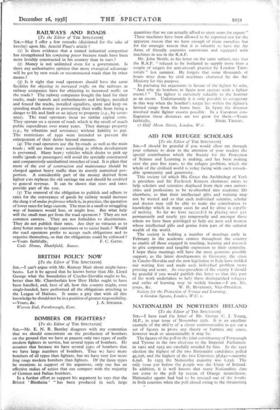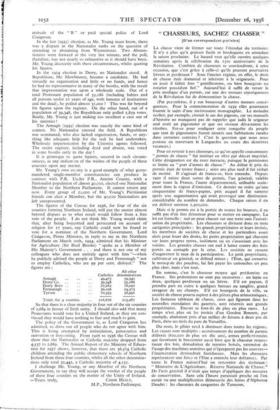NATIONALISM IN NORTHERN IRELAND
[To the Editor of THE SPECTATOR]
Sta,—I have read the letter of Mr. George C. J. Young,. M.P., in your issue of November 25th. It is an excellent example of the abilly of a clever controversialist to get out a set of figures to prove any theory or buttress any cause, however weak or unsustainable it may be.
The figures of the poll in the joint constituency of Fermanagh and Tyrone in the two elections to the Imperial Parliament in 1922 and 1923 are carefully avoided by him. In the 1922 election the highest of the two Nationalist candidates polled 45,236, and the highest of the two Unionists 38,640—majority 6,596. In 1923 the Nationalist majority was 6,256. The only issue put before the people was the Unity of Ireland. In addition, it is well known that many Nationalists dare not come to the poll by reason of Orange intimidation. Nationalist agents had had to be rescued out of the booths in both counties when the poll closed owing to the threatening attitude of the " B " or paid special police of Lord Craigavon.
In the last (1935) election, as Mr. Young must know, there was a dispute in the Nationalist ranks on the question of attending or abstaining from Westminster. Two Absten- tionists went forward at the very last minute, and the poll, therefore, was not nearly so exhaustive as it should have been. Mr. Young discreetly veils these circumstances, whilst quoting his figures.
In the 1924 election in Derry, no Nationalist stood. A Republican, Mr. Mawhinney, became a candidate. He had virtually no organisation and little or no funds, and hence he had no representative in many of the booths, with the result that impersonation was upon a wholesale scale. Out of a total Protestant population of 55,186 (including babies and all persons under 21 years of age, with inmates of institutions and the dead), he polled almost 3tpoo ! This was far beyond his figures upon the register. On the other hand, out of a population of 39,348, the Republican only polled 5,859 votes. Really, Mr. Young is just making too excellent a case out of his statistics !
The Armagh (1935) election was exactly the same kind of contest. No Nationalist entered the field. A Republican was nominated, who also lacked organisation, funds, or any- thing like adequate help for the task he had undertaken. Wholesale impersonation by the Unionist agents followed. The entire register, including dead and absent, was voted in some booths early in the day !
It is grotesque to quote figures, secured in such circum- stances, as any indication of the wishes of the people of these counties upon any matter.
Mr. Young's own coanty is a good example of what gerry- mandered single-member constituencies can _ produce in contrast with P.R. Under P.R., Antrim County, with a Nationalist population of almost 40,000, elected one Nationalist Member to the Northern Parliament. It cannot return any now. Every group of 22,000 of Mr. Young's Partitionist friends can elect a Member, but the 40,030 Nationalists are left unrepresented.
The figures of the Census for 1936, for four of the six counties forming Northern Ireland, will put the matter almost beyond dispute as to what result would follow from a free vote of the people. I do not think Mr. Young would claim that, after being boycotted and persecuted on account of religion for 17 years, any Catholio could now be found to vote for a nominee of the Northern Government. Lord Craigavon, Prime Minister, in reply to me in the Northern Parliament on March 20th, 1934, kdmitted that his Minister for Agriculture (Sir Basil Brooke) "spoke as a Member of His Majesty's Government . . . and there is not one of my colleagues who does not entirely agree with him "—when he publicly advised the people at Derry and Fermanagh "not to employ Catholics, who are 99 per cent. disloyal." The figures are : All other Catholics denominations Armagh 49,475 59,340 Derry Co. 39,348 55,186 Derry Boro 27,062 18,097 Fermanagh 30,196 24,373 Tyrone
70,595 56,991
Totals for 4 counties .. 216,676
213,987
So that there is a clear majority in four out of the six counties of 2,689 in favour of Irish unity. I 'should also add that many Protestants would vote for a United Ireland, as they are con- vinced they would have nothing to fear and much to gain.
The policy of the Government is, as Lord Craigavon has admitted, to drive out all people who do not agree with him. This is being attempted by intimidation, persecution and starvation or boycotting. From 1926 to 1936 the Census will show that the Nationalist or Catholic majority dropped from 4,537 to 2,689. The Annual Report of the Ministry of Educa- tion for 1937 shows, however, that there are 36,574 Catholic children attending the public elementary schools of Northern Ireland from these four counties, whilst all the other denomina- tions only total 32,442, a Catholic majority of 4,132.
I challenge Mr. Young, or any Member of the Northern Government, to say they will accept the verdict of the people of these four counties on the matter of the Unity of Ireland.
M.P., Northern Parliament.















































 Previous page
Previous page